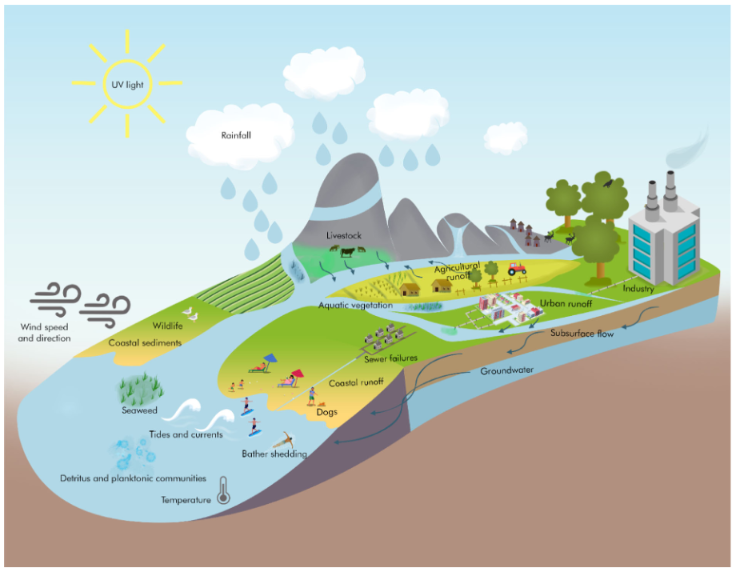A press release by the University of Reading earlier this week claims that:
The UK’s bathing water forecasts need urgent improvement to prevent beach goers from swimming in sewage without warning.
The University is publicising a review paper in the journal WIREs Water entitled “Forecasting bathing water quality in the UK: A critical review” that was first submitted in December 2022. According to the press release:
With increasing attention on UK water companies and others to clean up rivers and beaches, the review, published in WIREs Water, suggests current bathing water forecast models are not keeping the public safe at most of the UK’s 600-plus designated bathing water locations.
The current outdated methods cannot accurately predict threats from pollution caused by sudden downpours, the scientists say. Heavy rain can lead to sewage overflows or agricultural run-off. In addition, a lack of water quality sampling and outdated forecast methods leave people vulnerable to sudden increases in chemicals or bacteria in the water.
With coastal and wild swimming becoming more popular, local authorities urgently need to make use of improved forecasting techniques to identify the dangers from bugs such as E. coli or intestinal enterococci, which can be lethal, the researchers said.
According to lead author Karolina Krupska:
We expect beaches that are designated for swimming to be clean and safe, but authorities often don’t have good enough information to issue warnings, leaving swimmers and surfers more vulnerable to getting ill. The way we manage our sewage and land means rivers and seas are frequently polluted, and heavier summer downpours due to climate change is making the problem worse at the time of year when people are most likely to be at the beach.
With existing pollution warning systems, beach users don’t have good enough information to decide whether it is safe to go in the water. The science underpinning the next generation of bathing forecasting already exists, but a lack of action means these solutions have not been implemented.
We need a more reliable and frequently updated early warning system, to ensure people can safely enjoy a coastal swim with the confidence that they aren’t putting themselves at risk.
The abstract of the paper itself states more formally:
Climate change is altering rainfall patterns resulting in increasing variability and intensity of rainfall events worldwide. Increases to short duration, intense rainfall (i.e., convective rainfall), will lead to increases in sewage overflow and run-off from agricultural land. Such events generate spikes in micro-organisms from feces and manure, especially Escherichia coli (EC) and intestinal enterococci (IE), that temporarily end up in bathing waters posing serious health risks to bathers. Forecasting of bathing water quality associated with convective rain-fall presents a distinctive forecasting challenge due to high uncertainties associated with predicting the timing, location, and impact of such events. In this article, we review examples of bathing water quality forecasting practices, with a focus on the United Kingdom where convective rainfall in the summer bathing water season is a particular concern, and question whether the current approach is robust in a changing climate. We discuss potential upgrades in bathing water forecasting and identify the main challenges that must be addressed before an improved framework for bathing water forecasting can be achieved. Although developments in meteorological and hydrological short-range forecasting capabilities are promising, convective rainfall forecasting has significant predictability limits. We suggest taking full advantage of short-range forecasts to provide sub-daily bathing water forecasts, focusing on targeted bathing water monitoring regimes to improve model accuracy with the ultimate goal of providing improved information and guidance for beach users.

The introduction to the paper points out that:
Real-time monitoring and analysis of the microbiological status of bathing water quality is impractical due to the time that elapses between sample collection and laboratory analysis. During this time, the public may be exposed to elevated levels of pathogenic bacteria (bacteria that can cause disease) increasing the risk of faecal indicator organisms (FIO) driven gastrointestinal, respiratory, and skin infections. Remote sensing methods including imaging spectrometry have been used as an alternative to help obtain up-to-date and cost-effective information for bathing waters protection; however, these techniques must evolve further to be considered for operational use. Forecasting of bathing water quality is therefore vital to inform the public of the potential health risks and allow them to make informed choices
Unfortunately in all the circumstances the paper’s final conclusions are that:
High-quality bathing water forecasting is essential for providing timely and accurate information to the public, to warn them, to help them make informed choices, and to avoid health implications associated with poor bathing water quality. Despite this, it is not valued and recognized by organizations and beach users due to poor and sparse environmental data, outdated technological and science approaches, and opinions driven by political agendas. Adapting to the changing climate calls for immediate improvements in our current forecasting approach. The establishment of new funding streams will require time, effective engagement with stakeholders, and consideration of the challenges ahead.
If we are to reduce the risk from poor bathing water quality and avoid the increasing number of beachgoers reporting being ill after being diagnosed with EC poisoning, then we should endeavor to meet these challenges quickly and take advantage of recent scientific advances in forecasting. Considering the possibility of worsening bathing water quality due to our changing climate, addressing shortcomings in current bathing water forecasting operational practice should be a priority for government to keep our bathing water clean and people safe.
Almost the last words are:
No funding was received for this research.